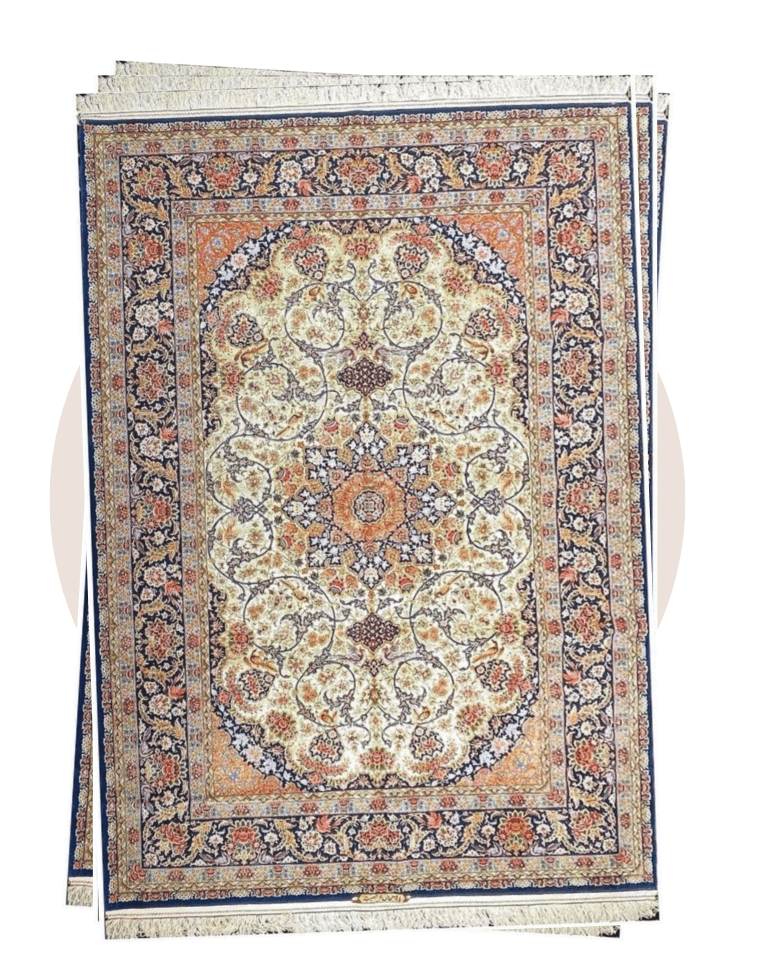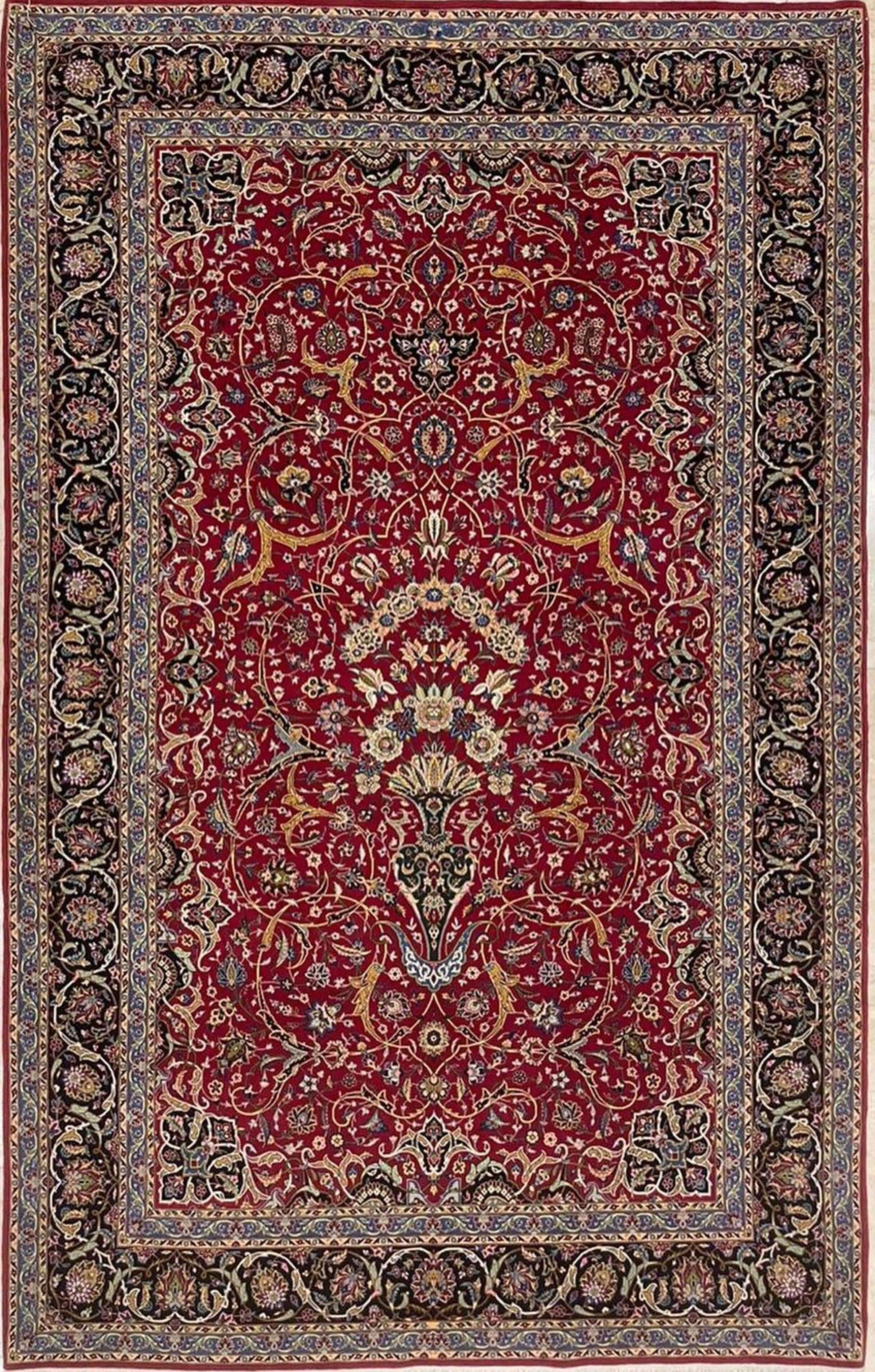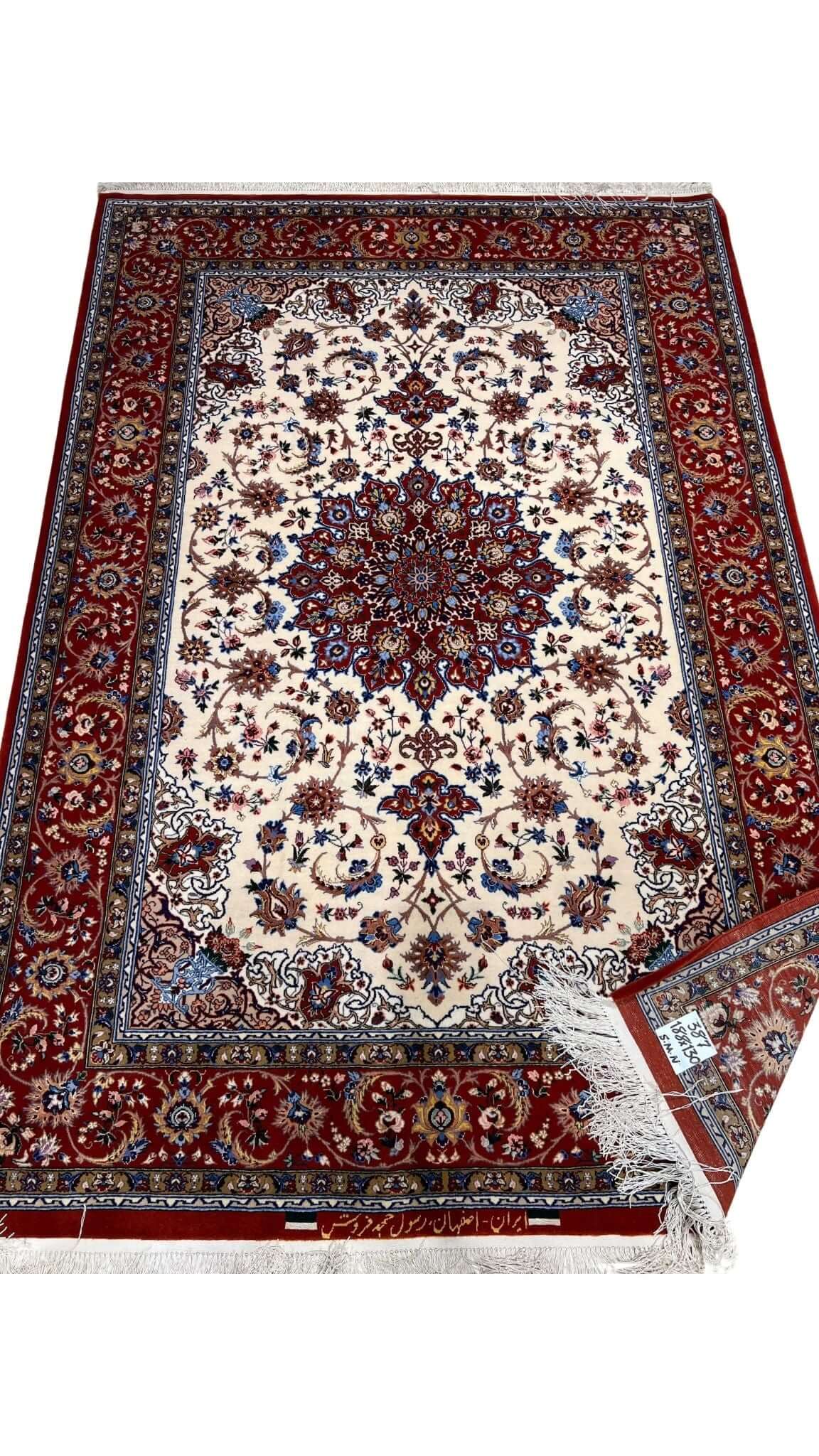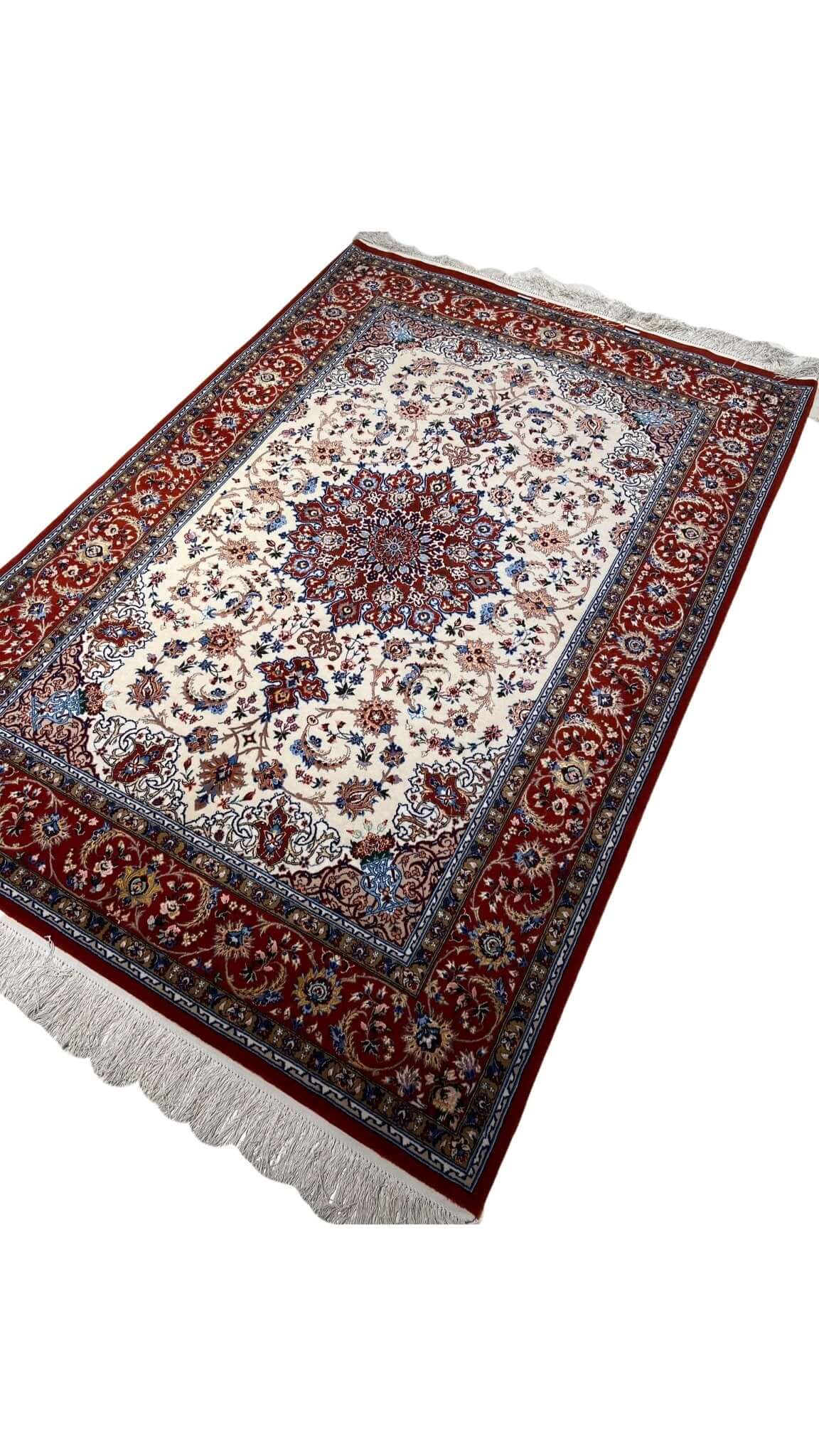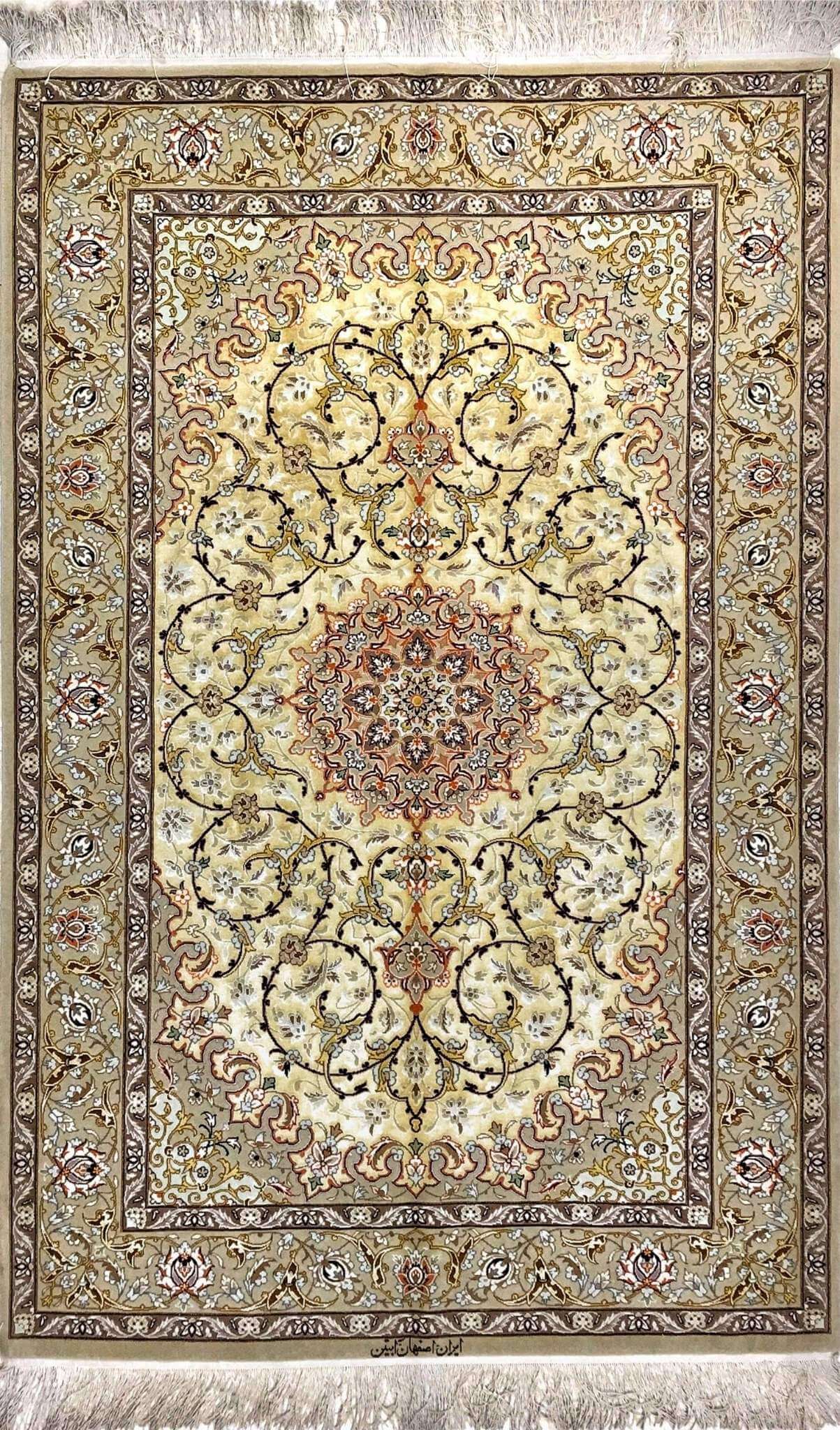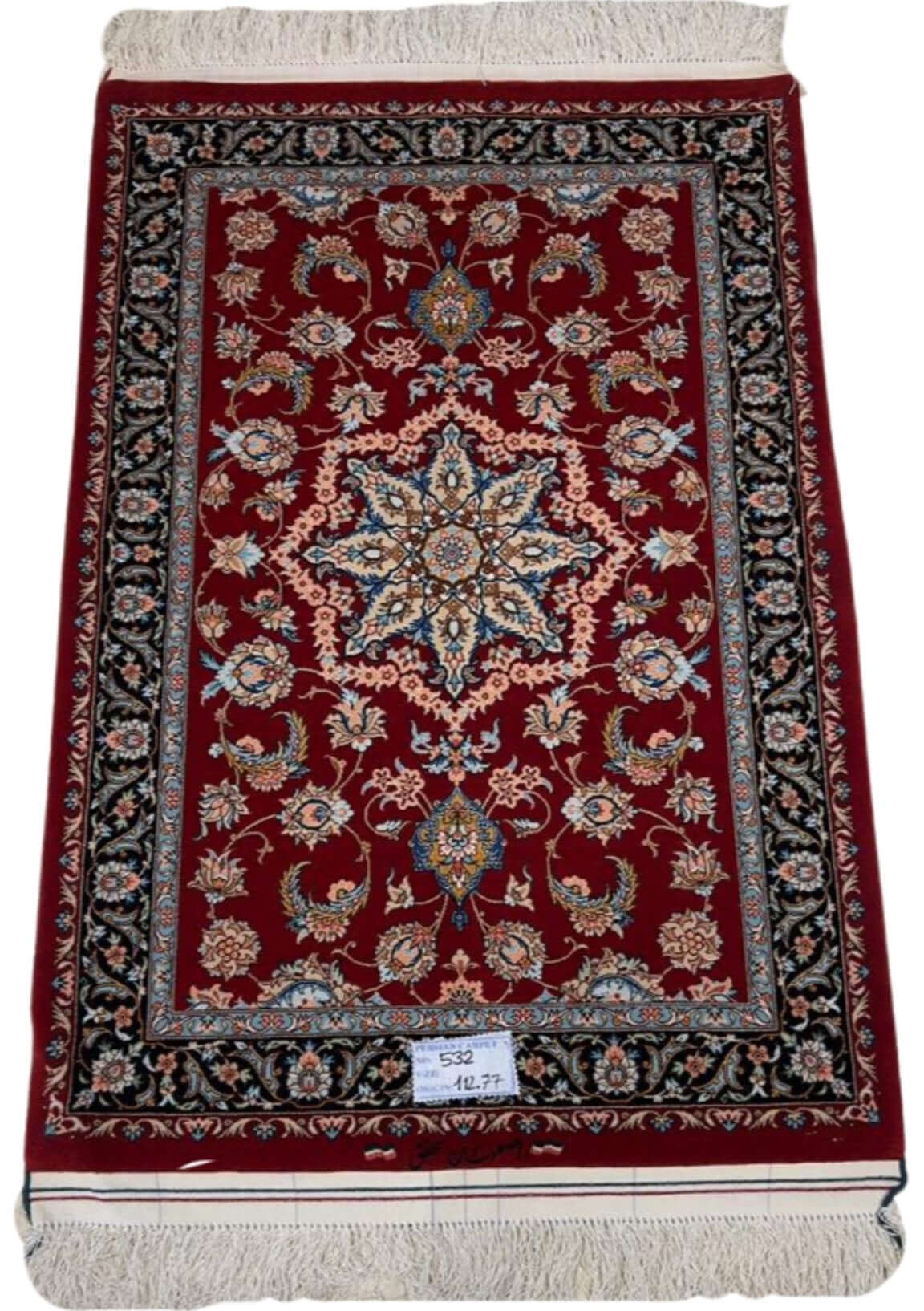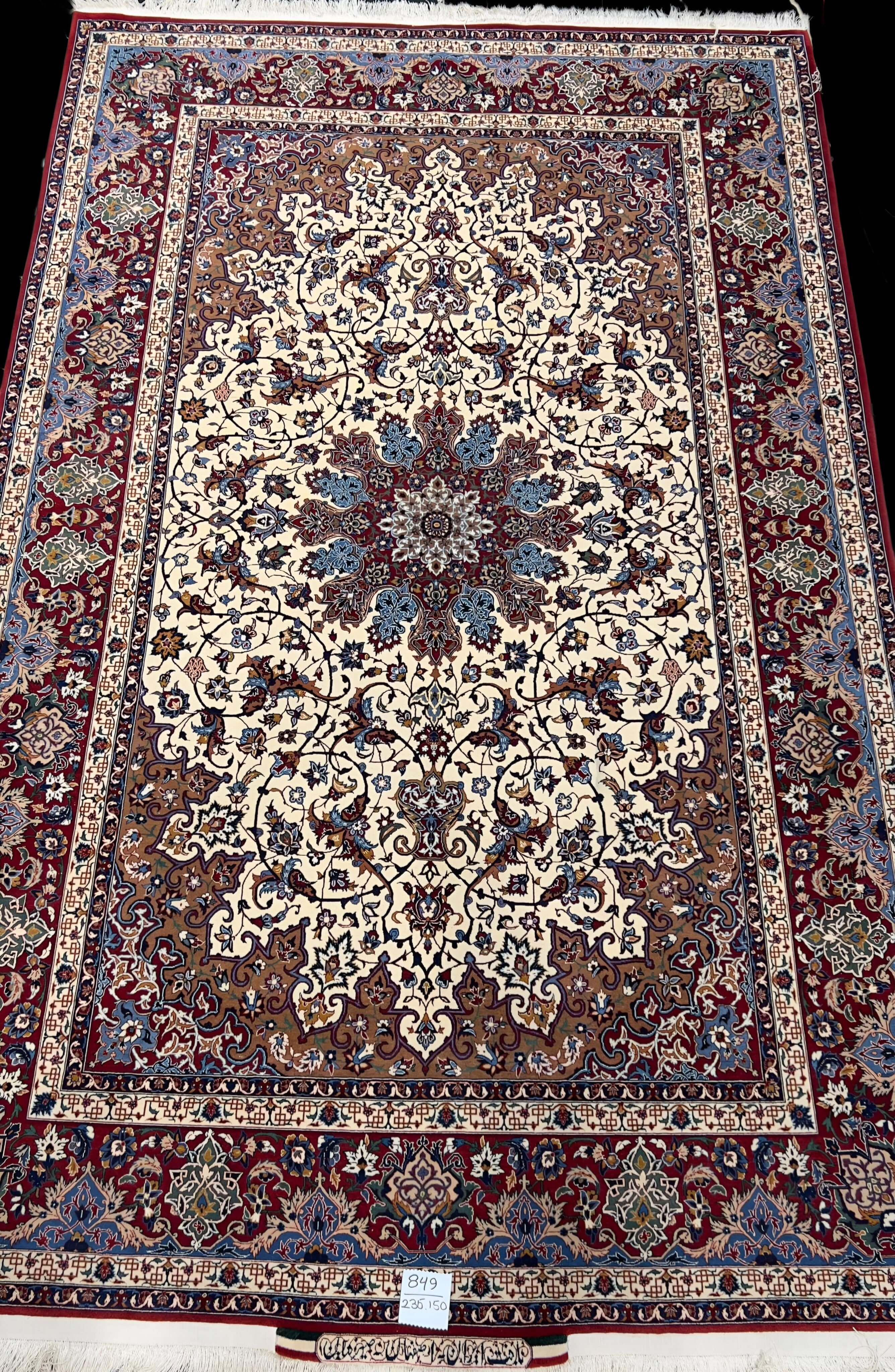"Tappeti Isfahan: eleganza persiana intrecciata a mano e tradizione senza tempo"
Scopri l'eleganza senza tempo dell'arte persiana con la nostra esclusiva **Collezione di tappeti Isfahan**. Realizzati a mano nell'antica città di Isfahan, questi tappeti sono celebrati in tutto il mondo per i loro disegni intricati, l'eccezionale maestria artigianale e i materiali lussuosi come seta e lana. Ogni pezzo di questa collezione è più di un semplice tappeto: è un simbolo della storia e della cultura persiana, meticolosamente tessuto da maestri artigiani utilizzando tecniche tramandate di generazione in generazione.
"Perché scegliere un tappeto Isfahan per la tua casa?"
I tappeti Isfahan sono rinomati per la loro straordinaria bellezza, l'eccezionale artigianalità e la qualità ineguagliabile, che li rendono uno dei tipi di **tappeti persiani** più ricercati. Che tu sia un collezionista, un intenditore di belle arti o semplicemente cerchi di migliorare l'arredamento della tua casa, un **tappeto Isfahan** è più di un semplice acquisto: è un investimento in tradizione, arte ed eleganza senza tempo. Caratterizzati da motivi intricati e da una lussuosa miscela di seta e lana, questi tappeti conferiscono raffinatezza e ricchezza culturale a qualsiasi spazio.
"Artigianato: l'arte dietro i tappeti di Isfahan"
I tappeti Isfahan esemplificano l'apice dell'artigianato persiano, annodati a mano utilizzando tecniche tradizionali perfezionate nel corso dei secoli. I maestri artigiani lavorano meticolosamente su telai verticali, seguendo modelli intricati che assicurano precisione in ogni nodo. Questi design dettagliati non solo evidenziano l'arte dietro ogni tappeto, ma garantiscono anche la durevolezza, rendendo ogni **tappeto Isfahan** un capolavoro senza tempo e un'aggiunta duratura alla tua casa.
"Tecniche di annodatura nei tappeti di Isfahan: precisione ed eleganza"
La tecnica di annodatura è una caratteristica distintiva della qualità e della complessità dei **tappeti Isfahan**. Questi capolavori utilizzano prevalentemente nodi singoli, noti anche come nodi persiani o Senneh, che consentono la creazione di motivi intricati e disegni ad alta densità di nodi. Al contrario, i nodi doppi, o nodi Ghiordes turchi, si trovano solitamente nei tappeti tribali o di qualità inferiore. La precisione dei tappeti a nodo singolo garantisce la loro superiore artigianalità, rendendo ogni **tappeto persiano Isfahan** un'opera d'arte che unisce durevolezza e dettagli squisiti.
"La precisione dei singoli nodi nei tappeti di Isfahan"
I nodi singoli, noti anche come nodi persiani o Senneh, sono una caratteristica distintiva dei **tappeti Isfahan**, celebrati per la loro precisione e complessità. Questa tecnica prevede l'avvolgimento del filato attorno a un singolo filo di ordito, creando una trama stretta e uniforme che consente agli artigiani di realizzare motivi altamente dettagliati e complessi. Il risultato è un capolavoro di arte persiana, in cui ogni nodo contribuisce alla squisita bellezza e durata del tappeto, assicurando che rimanga un'aggiunta senza tempo a qualsiasi casa.
"Perché i tappeti a nodo singolo sono preferiti nei tappeti Isfahan"
I tappeti a nodo singolo sono il massimo della precisione e dell'abilità artistica nei **tappeti Isfahan**, offrendo dettagli, flessibilità e durata senza pari. La struttura a nodo più stretto consente ai tessitori di creare intricati motivi floreali, medaglioni e arabeschi, che sono i tratti distintivi dei **tappeti persiani Isfahan**. Questa tecnica produce anche una superficie più liscia e raffinata, migliorando l'attrattiva visiva del tappeto.Nonostante il loro aspetto delicato, i tappeti a nodo singolo sono incredibilmente resistenti se realizzati con materiali di alta qualità come lana e seta, il che ne fa un investimento senza tempo, sia in termini di bellezza che di funzionalità.
"Comprendere i doppi nodi nei tappeti persiani"
I doppi nodi, detti anche nodi turchi o Ghiordes, si trovano comunemente nei tappeti tribali o più robusti piuttosto che nei raffinati **tappeti persiani Isfahan**. Questa tecnica di annodatura prevede l'avvolgimento del filato attorno a due fili di ordito, dando vita a un tappeto più spesso e robusto. Mentre i tappeti a doppio nodo sono apprezzati per la loro durevolezza, questo metodo spesso limita il livello di dettaglio e complessità ottenibile nel design, rendendoli più adatti ad aree funzionali e ad alto traffico piuttosto che a mostrare un'intricata arte.
"Caratteristiche principali dei tappeti a doppio nodo"
I tappeti a doppio nodo sono riconosciuti per la loro costruzione robusta e l'idoneità per aree ad alto traffico. Questi tappeti presentano un pelo più spesso, offrendo una durata eccezionale, sebbene i loro disegni siano spesso più geometrici o semplicistici a causa dello spazio occupato dal doppio nodo. Comunemente utilizzata nei tappeti tribali e dei villaggi, la tecnica del doppio nodo prevede l'avvolgimento del filato attorno a due fili di ordito adiacenti, creando una struttura forte e sostanziale. Sebbene non abbiano i dettagli intricati dei tappeti a nodo singolo, i tappeti a doppio nodo eccellono in praticità e longevità, rendendoli ideali per spazi funzionali.
"La superiorità dei nodi singoli nei tappeti di Isfahan"
I nodi singoli sono il segno distintivo dei **tappeti Isfahan** di alta qualità, che stabiliscono lo standard per il design intricato e l'artigianalità superiore. Questo metodo di annodatura consente agli artigiani di creare i motivi e i motivi elaborati che definiscono questi tappeti, tra cui disegni floreali, medaglioni centrali e delicati arabeschi. Con una densità di nodi che spesso supera i 500-1.000 nodi per pollice quadrato (KPSI), i tappeti a nodo singolo raggiungono dettagli ineguagliabili, texture lisce e un aspetto lussuoso, rendendoli un vero capolavoro dell'arte persiana.
"Il ruolo dei doppi nodi nei tappeti di fascia bassa"
I doppi nodi, sebbene raramente utilizzati nei **tappeti Isfahan** di alta qualità, sono comuni nei pezzi di qualità inferiore o prodotti in serie. Questa tecnica di annodatura consente una tessitura più rapida e produce tappeti con motivi più grandi e semplici e una finitura meno raffinata. Nonostante la loro ridotta complessità, i tappeti a doppio nodo sono molto resistenti, il che li rende una scelta eccellente per scopi utilitaristici in cui la resistenza e la longevità hanno la precedenza sui dettagli artistici.
"Densità dei nodi e il suo impatto sul valore del tappeto Isfahan"
La densità dei nodi, misurata in KPSI (nodi per pollice quadrato) o nodi per centimetro quadrato, è un fattore cruciale per determinare il valore e la qualità di un **tappeto Isfahan**. Una densità di nodi più elevata, spesso ottenuta con nodi singoli, riflette il lavoro e l'abilità coinvolti nella creazione di disegni intricati, rendendo questi tappeti più preziosi e molto ricercati. I tappeti con densità di nodi più elevate sono considerati opere d'arte senza tempo e possono mantenere o persino aumentare di valore nel tempo.
- **Elevata densità di nodi (nodo singolo)**: varia da 500 a oltre 1.000 KPSI (da 77 a 155 nodi per cm²) nei tappeti Isfahan più pregiati, consentendo ai tessitori di ottenere motivi dettagliati e un'abilità artistica eccezionale.
- **Bassa densità di nodi (doppio nodo)**: in genere inferiore a 500 KPSI (meno di 77 nodi per cm²), comune nei tappeti tribali o funzionali con disegni più semplici e trame più grossolane.
"Conclusione: come scegliere il tappeto Isfahan perfetto per le tue esigenze"
Scegliere la tecnica di annodatura giusta è essenziale quando si investe in un **tappeto Isfahan**, poiché influenza direttamente la qualità e lo scopo del tappeto. Per coloro che cercano un capolavoro di artigianato persiano, i tappeti Isfahan a singolo annodo offrono un'arte senza pari e disegni intricati, rendendoli un'aggiunta preziosa a qualsiasi collezione. Al contrario, i tappeti a doppio annodo sono una scelta pratica per le aree ad alto traffico, offrendo durevolezza e robustezza, sebbene con motivi più semplici.
**In sintesi:**
- **Nodi singoli (persiani/senneh)**: preferiti per tappeti Isfahan pregiati e di alta qualità, che consentono disegni intricati e un'elevata densità di nodi (500-1.000+ KPSI).
- **Doppio nodo (turco/ghiordes)**: si trovano nei tappeti economici o funzionali, sono resistenti ma meno dettagliati e la densità dei nodi è solitamente inferiore a 500 KPSI.
Conoscere queste tecniche ti aiuterà ad apprezzare la maestria artigianale dietro ogni tappeto e a scegliere quello più adatto alle tue esigenze, che si tratti di uno squisito pezzo d'arte persiana o di un tappeto resistente per l'uso quotidiano.
"Materiali e colori: l'essenza dei tappeti di Isfahan"
I tappeti Isfahan sono realizzati utilizzando i migliori materiali naturali, selezionati per la loro bellezza e durevolezza. La combinazione di lana e seta si traduce in una consistenza lussuosa e una qualità duratura, garantendo che questi tappeti possano essere amati per generazioni. La lana, proveniente da regioni come Kerman e Kermanshah o importata dall'Australia per il suo vello superiore, aggiunge resistenza e ricchezza a ogni tappeto.
**Combinazioni comuni di materiali:**
- **Lana su cotone**: una miscela resistente e dalla consistenza squisitamente fine, ampiamente utilizzata nei tappeti Isfahan.
- **Misto lana e seta**: aggiunge un aspetto raffinato, con la seta che esalta i dettagli dei motivi e conferisce una delicata lucentezza.
- **Seta su seta**: l'opzione più lussuosa, caratterizzata da un pelo di seta su una base di seta per una morbidezza senza pari e dettagli intricati.
I tappeti Isfahan si distinguono anche per le loro armoniose palette di colori, che mescolano blu profondi, rossi vibranti, ori intensi e morbidi avori. Queste tonalità sono tradizionalmente ottenute con tinture vegetali, garantendo tonalità vibranti e resistenti allo sbiadimento che esaltano il fascino senza tempo del tappeto.
.
"I disegni dei tappeti di Isfahan: arte e simbolismo culturale"
Gli intricati disegni dei **tappeti Isfahan** sono tra i più dettagliati e simbolicamente significativi nella produzione di tappeti persiani. Caratterizzati da motivi floreali, arabeschi, medaglioni e motivi centrali toranj, questi disegni riflettono temi di natura, spiritualità e universo. Ogni tappeto è un mix di arte e narrazione, rendendolo un pezzo senza tempo del patrimonio persiano.
**Elementi di design popolari:**
- **Shah Abbasi**: ispirato al sovrano safavide, questo design presenta grandi motivi floreali simmetrici e palmette.
- **Lachak Toranj**: un medaglione centrale completato da quattro angoli, che simboleggiano armonia ed equilibrio.
- **Viticci arabeschi**: linee fluide e curve che rappresentano la vita eterna e la continuità.
- **Fasce di nuvole**: motivi celestiali dell'era safavide, che simboleggiano la bellezza e la grazia celestiali.
Questi disegni non sono semplicemente decorativi, ma racchiudono un profondo significato culturale, rendendo ogni **tappeto Isfahan** un pezzo unico di storia persiana e di maestria artistica.
"Tappeti antichi di Isfahan: un tesoro senza tempo per i collezionisti"
La nostra collezione comprende **tappeti antichi Isfahan** che risalgono al XVII secolo, l'apice dei risultati artistici della dinastia safavide. Questi tappeti sono celebrati come alcuni dei più raffinati mai realizzati, esibendo design ineguagliabili e una maestria artigianale eccezionale. Molti presentano motivi rari e squisiti, come il design Shah Safi e i tappeti polonaise in seta, originariamente commissionati per le corti reali.
Possedere un **tappeto antico Isfahan** è come possedere un pezzo di storia. Questi capolavori molto ricercati hanno affascinato i collezionisti per secoli, con alcuni esemplari che hanno raggiunto prezzi da record alle aste internazionali. Un esempio degno di nota è un tappeto Isfahan del XVII secolo venduto per 34 milioni di dollari da Sotheby's, sottolineando il valore e la rarità senza pari di questi pezzi iconici.
"Costruzione e durata: la longevità dei tappeti di Isfahan"
I tappeti Isfahan sono rinomati per la loro squisita bellezza e la loro eccezionale durevolezza. Questi tappeti sono meticolosamente annodati a mano utilizzando tecniche consolidate che garantiscono la loro resistenza nel tempo. Realizzati con materiali di alta qualità, tra cui miscele di lana e seta e basi in pura seta, sono altamente resistenti all'usura e mantengono le loro condizioni incontaminate per generazioni.
Che sia posizionato in un'area molto frequentata o esposto come opera d'arte, un **tappeto Isfahan** conserva la sua integrità strutturale e la sua eleganza senza tempo. La sua durevolezza e la sua artigianalità lo rendono non solo un pezzo decorativo, ma un investimento duraturo nell'arte e nella qualità persiana.
"Dimensioni e forme dei tappeti Isfahan: perfetti per ogni spazio"
La nostra **Collezione tappeti Isfahan** offre un'ampia gamma di dimensioni e forme per completare qualsiasi stile di interior design. Che tu abbia bisogno di un piccolo tappeto decorativo per valorizzare un angolo accogliente o di un grande pezzo di design per ancorare il tuo soggiorno, abbiamo il tappeto perfetto per te.
**Dimensioni comuni:**
- **Da piccola a media**: ideale per spazi intimi, le dimensioni più diffuse sono 3x5 e 4x6 piedi.
- **Grande**: Perfetto per aree spaziose, con dimensioni come 6x9, 8x11 e 9x12 piedi.
- **Forme speciali**: configurazioni uniche come tappeti rotondi, esagonali e ottagonali per spazi particolari.
Tradizionalmente, i tessitori di Isfahan erano specializzati in tappeti rettangolari. Tuttavia, le tendenze del design contemporaneo hanno ispirato la creazione di tappeti quadrati e circolari, assicurando che ci sia uno straordinario **tappeto Isfahan** adatto a ogni spazio moderno o tradizionale.
"Un investimento senza tempo: il valore dei tappeti di Isfahan"
Un **tappeto Isfahan** è molto più di un semplice elemento decorativo: è un investimento duraturo in arte, cultura e storia. Per secoli, questi tappeti sono stati amati da collezionisti e interior designer per la loro bellezza senza pari, la maestria artigianale e la durevolezza eccezionale. Ogni tappeto rappresenta un pezzo di eredità persiana, offrendo non solo fascino estetico ma anche un significato storico.
Possedere un **tappeto Isfahan** è un'eredità che può essere tramandata di generazione in generazione. Con l'invecchiamento, questi tappeti spesso aumentano di valore, rendendoli un tesoro senza tempo che fonde arte e valore duraturo.
"Tappeti Isfahan in vendita: alla scoperta di autentici capolavori persiani"
Il mercato dei **tappeti Isfahan** è sia esclusivo che molto ricercato, con questi tappeti persiani finemente lavorati che catturano l'attenzione di collezionisti e intenditori in tutto il mondo. Quando si cerca un **tappeto Isfahan in vendita**, autenticità, origine e artigianalità sono fattori critici da considerare. Questi elementi non solo determinano il valore e l'unicità del tappeto, ma assicurano anche che rimanga un investimento duraturo nell'arte e nella tradizione persiana.
"Dove acquistare tappeti Isfahan: fonti affidabili per tappeti persiani autentici"
**I tappeti Isfahan** sono tra i tappeti persiani più ambiti, disponibili tramite diversi canali affidabili:
- **Gallerie specializzate in tappeti**: rinomate gallerie offrono selezioni attentamente curate di **tappeti Isfahan**, garantendo che ogni pezzo soddisfi i più elevati standard di artigianalità e autenticità.
- **Rivenditori online**: I rivenditori online affermati offrono un modo comodo per acquistare **tappeti persiani autentici**. Cerca certificati di autenticità e politiche di reso per garantire qualità e tranquillità.
- **Aste**: sedi prestigiose come Sotheby's e Christie's propongono **tappeti Isfahan** rari e antichi, spesso accompagnati da provenienza verificata, il che li rende investimenti ideali per i collezionisti.
- **Direttamente dall'Iran**: Acquistando tappeti direttamente dalla regione si possono scoprire pezzi unici, ma gli acquirenti devono prestare attenzione per garantirne l'autenticità e la qualità.
Da **House of Persian Carpets**, semplifichiamo il processo di acquisto offrendo **tappeti Isfahan** verificati. Ogni tappeto è corredato da descrizioni dettagliate dei suoi materiali, densità dei nodi e significato storico, assicurandoti un acquisto sicuro e informato.
"Materiali, lavorazione artigianale e considerazioni chiave per i tappeti di Isfahan"
**Materiali e lavorazione:**
- **Qualità della lana e della seta**: i tradizionali **tappeti Isfahan** presentano un vello di lana di alta qualità spesso mescolato con seta per una maggiore lucentezza. Gli esempi più pregiati sono tessuti interamente in seta, il che li rende eccezionalmente morbidi e lussuosi.
- **Base**: Questi tappeti hanno solitamente una base in cotone o seta; i tappeti in seta su seta sono i più delicati e preziosi e offrono una precisione nel design senza pari.
- **Densità dei nodi**: l'elevata densità dei nodi, che spesso supera i 500-1.000 nodi per pollice quadrato (KPSI), è un segno distintivo dei pregiati **tappeti Isfahan**, che consentono di realizzare motivi intricati e dettagliati.
- **Design e simbolismo**: rinomati per i loro disegni intricati, i tappeti Isfahan presentano medaglioni, arabeschi floreali e motivi geometrici come toranj e lachak toranj. Questi motivi spesso simboleggiano temi di natura, spiritualità e vita eterna, riflettendo il ricco patrimonio culturale della Persia.
**Dimensioni del tappeto:**
I tappeti Isfahan sono disponibili in varie misure per adattarsi a qualsiasi spazio, dai piccoli tappeti decorativi ai grandi pezzi statement per salotti o sale da pranzo. Le misure più diffuse includono 4x6, 6x9 e 9x12. Misurare lo spazio in anticipo assicura la perfetta vestibilità del tappeto.
**Condizione:**
Le condizioni degli antichi **tappeti Isfahan** svolgono un ruolo significativo nel determinare il loro valore. I pezzi ben conservati con usura minima sono molto più preziosi di quelli con invecchiamento o danni visibili. Quando si acquista da un'asta o da una galleria, verificare sempre che il tappeto sia stato valutato per esigenze di restauro e potenziali danni per fare un investimento consapevole.
"I tappeti di Isfahan: un investimento senza tempo nell'arte e nella cultura"
Possedere un **tappeto Isfahan** non significa solo migliorare l'arredamento della tua casa: è un investimento a lungo termine in arte e cultura. Questi tappeti sono stati amati dai collezionisti per secoli, apprezzati per la loro eccezionale fattura, durevolezza e importanza storica.
**Tappeti antichi di Isfahan**: I tappeti del periodo safavide (XVI-XVII secolo) sono particolarmente apprezzati. Spesso commissionati per le corti reali, questi pezzi presentano disegni intricati ispirati all'architettura e all'arte persiana. Considerati oggetti da collezione, hanno un immenso valore storico e possono aumentare di valore in modo significativo nel tempo.
**Tappeti moderni Isfahan**: I **tappeti Isfahan** contemporanei, realizzati con la stessa meticolosa attenzione ai dettagli e alla tradizione, hanno anche un valore sostanziale. Invecchiando, questi tappeti rimangono molto ricercati nei mercati internazionali, il che li rende un investimento saggio sia per la bellezza che per il valore.
Acquistando da un venditore affidabile come **House of Persian Carpets**, avrai la certezza che il tuo investimento sarà autentico e della massima qualità, offrendo sia un'eleganza senza tempo sia il potenziale di aumento del valore nel corso degli anni.
"Perché acquistare da House of Persian Carpets?"
Presso **House of Persian Carpets**, siamo orgogliosi di offrire solo i migliori e autentici **tappeti Isfahan** direttamente dai tessitori più rinomati dell'Iran. Ogni tappeto della nostra collezione è meticolosamente selezionato per la sua fattura, il design intricato e i materiali di prima qualità, assicurando ai nostri clienti un capolavoro senza tempo che sarà amato per generazioni.
**Valutazione degli esperti**: Ogni **tappeto Isfahan** viene verificato da periti esperti che ne valutano le condizioni, la densità dei nodi e il significato storico, garantendone l'autenticità e il valore.
**Ampia scelta**: che tu stia cercando un **tappeto Isfahan** appena realizzato o un raro pezzo antico, la nostra vasta collezione offre una varietà di modelli e dimensioni per soddisfare ogni preferenza ed esigenza.
**Garanzia di soddisfazione**: ci impegniamo a garantire la soddisfazione del cliente, offrendo una politica di reso senza problemi, così puoi effettuare il tuo acquisto in totale sicurezza.
Scoprite l'incomparabile bellezza e qualità dei **tappeti Isfahan** con la certezza di investire in un autentico pezzo di artigianato persiano.




